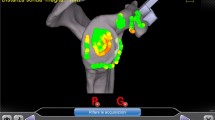Abstract
Objective
Optimal position and fixation of the baseplate is essential for the longevity of the reverse shoulder arthroplasty (RSA) and the patient-specific instrumentation (PSI) can help the surgeon to achieve that purpose. The aim of this study was to assess the reliability of the PSI guides for the positioning of the baseplate and the fixation’s screws.
Method
Prospective study involving 35 patients operated for RSA. The PSI guides were planned and used by the senior surgeon in all cases. We compared the planned orientation (frontal and axial) of the baseplate and the screws with the post-operative CT scan.
Results
The mean difference between the planned measures and the post-op measures was inferior to 2.5°. The screw’s length corresponded with the pre-op plan in 70% of the cases.
Conclusion
The use of a PSI guide to position the glenoid implant in total reverse shoulder arthroplasty is reliable, reduces the risk of positioning errors and improves the quality of fixation with the screws.





Similar content being viewed by others
References
Boileau P, Watkinson D, Hatzidakis AM, Hovorka I (2006) Neer award 2005: the Grammont reverse shoulder prosthesis: results in cuff tear arthritis, fracture sequelae, and revision arthroplasty. J Shoulder Elb Surg 15(5):527–540. https://doi.org/10.1016/j.jse.2006.01.003
Favard L, Levigne C, Nerot C, Gerber C, De Wilde L, Mole D (2011) Reverse prostheses in arthropathies with cuff tear: are survivorship and function maintained over time? Clin Orthop Relat Res 469(9):2469–2475. https://doi.org/10.1007/s11999-011-1833-y
Sirveaux F, Favard L, Oudet D, Huquet D, Walch G, Mole D (2004) Grammont inverted total shoulder arthroplasty in the treatment of glenohumeral osteoarthritis with massive rupture of the cuff. Results of a multicentre study of 80 shoulders. J Bone Joint Surg (Br) 86(3):388–395
de Wilde LF, Poncet D, Middernacht B, Ekelund A (2010) Prosthetic overhang is the most effective way to prevent scapular conflict in a reverse total shoulder prosthesis. Acta Orthop 81(6):719–726. https://doi.org/10.3109/17453674.2010.538354
Friedman RJ, Barcel DA, Eichinger JK (2019) Scapular notching in reverse total shoulder arthroplasty. J Am Acad Orthop Surg 27(6):200–209. https://doi.org/10.5435/JAAOS-D-17-00026
Katz D, Valenti P, Kany J, Elkholti K, Werthel JD (2016) Does lateralisation of the Centre of rotation in reverse shoulder arthroplasty avoid scapular notching? Clinical and radiological review of one hundred and forty cases with forty five months of follow-up. Int Orthop 40(1):99–108. https://doi.org/10.1007/s00264-015-2976-3
Eraly K, Stoffelen D, Vander Sloten J, Jonkers I, Debeer P (2016) A patient-specific guide for optimizing custom-made glenoid implantation in cases of severe glenoid defects: an in vitro study. J Shoulder Elb Surg 25(5):837–845. https://doi.org/10.1016/j.jse.2015.09.034
Levy JC, Everding NG, Frankle MA, Keppler LJ (2014) Accuracy of patient-specific guided glenoid baseplate positioning for reverse shoulder arthroplasty. J Shoulder Elb Surg 23(10):1563–1567. https://doi.org/10.1016/j.jse.2014.01.051
Walch G, Vezeridis PS, Boileau P, Deransart P, Chaoui J (2015) Three-dimensional planning and use of patient-specific guides improve glenoid component position: an in vitro study. J Shoulder Elb Surg 24(2):302–309. https://doi.org/10.1016/j.jse.2014.05.029
Dallalana RJ, McMahon RA, East B, Geraghty L (2016) Accuracy of patient-specific instrumentation in anatomic and reverse total shoulder arthroplasty. Int J Shoulder Surg 10(2):59–66. https://doi.org/10.4103/0973-6042.180717
Heylen S, Van Haver A, Vuylsteke K, Declercq G, Verborgt O (2016) Patient-specific instrument guidance of glenoid component implantation reduces inclination variability in total and reverse shoulder arthroplasty. J Shoulder Elb Surg 25(2):186–192. https://doi.org/10.1016/j.jse.2015.07.024
Iannotti JP, Ricchetti ET, Rodriguez EJ, Bryan JA (2013) Development and validation of a new method of 3-dimensional assessment of glenoid and humeral component position after total shoulder arthroplasty. J Shoulder Elb Surg 22(10):1413–1422. https://doi.org/10.1016/j.jse.2013.01.005
Kwon YW, Powell KA, Yum JK, Brems JJ, Iannotti JP (2005) Use of three-dimensional computed tomography for the analysis of the glenoid anatomy. J Shoulder Elb Surg 14(1):85–90. https://doi.org/10.1016/j.jse.2004.04.011
Hendel MD, Bryan JA, Barsoum WK, Rodriguez EJ, Brems JJ, Evans PJ, Iannotti JP (2012) Comparison of patient-specific instruments with standard surgical instruments in determining glenoid component position: a randomized prospective clinical trial. J Bone Joint Surg Am 94(23):2167–2175. https://doi.org/10.2106/JBJS.K.01209
Molony DC, Cassar Gheiti AJ, Kennedy J, Green C, Schepens A, Mullett HJ (2011) A cadaveric model for suprascapular nerve injury during glenoid component screw insertion in reverse-geometry shoulder arthroplasty. J Shoulder Elb Surg 20(8):1323–1327. https://doi.org/10.1016/j.jse.2011.02.014
Shishido H, Kikuchi S (2001) Injury of the suprascapular nerve in shoulder surgery: an anatomic study. J Shoulder Elb Surg 10(4):372–376. https://doi.org/10.1067/mse.2001.115988
Chebli C, Huber P, Watling J, Bertelsen A, Bicknell RT, Matsen F 3rd (2008) Factors affecting fixation of the glenoid component of a reverse total shoulder prosthesis. J Shoulder Elb Surg 17(2):323–327. https://doi.org/10.1016/j.jse.2007.07.015
DiStefano JG, Park AY, Nguyen TQ, Diederichs G, Buckley JM, Montgomery WH 3rd (2011) Optimal screw placement for base plate fixation in reverse total shoulder arthroplasty. J Shoulder Elb Surg 20(3):467–476. https://doi.org/10.1016/j.jse.2010.06.001
Humphrey CS, Kelly JD 2nd, Norris TR (2008) Optimizing glenosphere position and fixation in reverse shoulder arthroplasty, part two: the three-column concept. J Shoulder Elb Surg 17(4):595–601. https://doi.org/10.1016/j.jse.2008.05.038
Author information
Authors and Affiliations
Corresponding author
Ethics declarations
Conflict of interest
The authors declare that they have no conflict of interest.
Additional information
Publisher’s note
Springer Nature remains neutral with regard to jurisdictional claims in published maps and institutional affiliations.
Rights and permissions
About this article
Cite this article
Marcoin, A., Nerot, C., Lestra, T. et al. The precision of patient-specific instrumentation guides for the positioning of the glenoid component in total reverse shoulder arthroplasty: an in vivo scanographic study. International Orthopaedics (SICOT) 44, 1761–1766 (2020). https://doi.org/10.1007/s00264-020-04524-x
Received:
Accepted:
Published:
Issue Date:
DOI: https://doi.org/10.1007/s00264-020-04524-x




